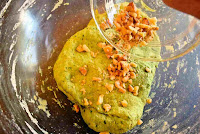One of our bagels takes advantage of kale for a deeper flavor, which is especially noticeable when toasted, while toasting also intensifies the crunch of walnuts.
This is a variation based on a plain version I adapted from ChefSteps (Amazing Chewy Bagels From Scratch). In my adaptation, shiokoji salted rice malt to lower sodium content also conditions the dough, making it softer and triggering a Maillard reaction due to its enzymes. For this reason, I do not use diastatic malt powder, which the original recipe lists as a key ingredient, but I do use non-diastatic malt powder for flavoring. Yet considering kale's effect of making the dough taste slightly "earthy and green," non-diastatic malt powder may not be needed at all in the recipe below. Until I experiment further, this is what appears at our table. These are smallish bagels packed with flavor.
1 bagel (1/8 recipe; 74 g baked):
219 calories; 6.8 g protein; 4.3 g fat; 37.7 g carbohydrate; 34.8 g net carbs; 93 mg sodium; 0 mg cholesterol; 2.9 g fiber
<Ingredients>
For sponge
140 g high-gluten flour1 bagel (1/8 recipe; 74 g baked):
219 calories; 6.8 g protein; 4.3 g fat; 37.7 g carbohydrate; 34.8 g net carbs; 93 mg sodium; 0 mg cholesterol; 2.9 g fiber
<Ingredients>
For sponge
100 g kale
100 cc water
2 g instant yeast
For dough
60 g whole wheat flour
15 g non-diastatic malt powder
10 g agave syrup
4 tsp (1 tbsp + 1 tsp) shiokoji salted rice malt
40 g walnuts
For kettling (not in photo)
2 liters water
2 tsp baking soda
1 tsp barley malt syrup
1-2 tbsp potato starch (or tapioca or corn starch, to dust surface of a container; not in photo)
<Directions>
1.
Make the sponge.
Chop kale, add 60-70 cc water from the specified amount (100 cc) for the sponge, and puree.
Transfer to a large, shallow bowl. Rinse remaining pureed kale with the remaining water into the bowl, and obtain 200 g in total (if short, add more water).
Microwave for 30 seconds to about body temperature or slightly warmer.
Add flour and yeast, mix, cover, and let sit for 2-4 hours until the mixture has active bubbles.
(3 hours later in photo)
Bubbles are not very clear due to kale content on the top surface, and foamy texture can be seen from the bottom.
2.
Meanwhile, dry toast walnuts in frying pan, and chop.
3.
Make the dough.
Add all ingredients for the dough, other than walnuts, to the sponge, and mix.
After switching to your hand to knead, if the dough feels too tough to knead, add a small amount of water (5 cc/1 tsp or so at a time).
If the dough feels too sticky, add flour (5-10 g).
When texture is right, add walnuts, and continue kneading for 15+ minutes.
Cover, and let sit for 10 minutes.
3.
Divide the dough into 8, and form balls.
Cover, and let sit for 15-20 minutes.
(The dough is relatively dry, and balls do not stick to each other to any significant degree when left only a short time. If worried, place them apart.)
4.
In the meantime, dust the proofing surface with potato starch, and shake off excess.
(Or, grease the surface with oil.)
5.
Pinch center of each ball to make a hole.
Put a finger of both hands through the hole from each side, and roll the bagel around fingers to expand the hole to 4-5 cm.
Place on surface dusted with potato starch, cover, and proof in the fridge overnight (up to two nights).
6.
Preheat oven to 425F/220C.
7.
In a large pot, bring water to boil for kettling.
Add baking soda and barley malt syrup.
8.
When oven is ready, put bagels in boiling kettling water, and boil each side 30-40 seconds.
Scoop, transfer to (paper) towel for a second, and place on baking sheet.
9.
Immediately bake for 15 minutes.
When done, transfer to wire rack, and cool.
<Notes>
- Shiokoji salted rice malt is used mainly as a salt substitute above. Among shiokoji's enzymes, amylase and protease both soften the dough. Protease also contributes to the Maillard reaction. My shiokoji has 8% sodium. Store-bought shiokoji generally contains around 12% sodium. Functions of these enzymes are said to be weaker when sodium percentage of shiokoji increases, in case you see a different baking result with shiokoji at a much higher or lower sodium level.
- Without adjustment (when following the original recipe), each bagel in the same size as above would contain about 350 mg sodium, which is actually not particularly high compared to many commercial bagels.
- Potato (tapioca, corn) starch prevents the dough from sticking to the surface. It is much easier to clean than oil.
(Last updated: July 16, 2019)





























No comments:
Post a Comment